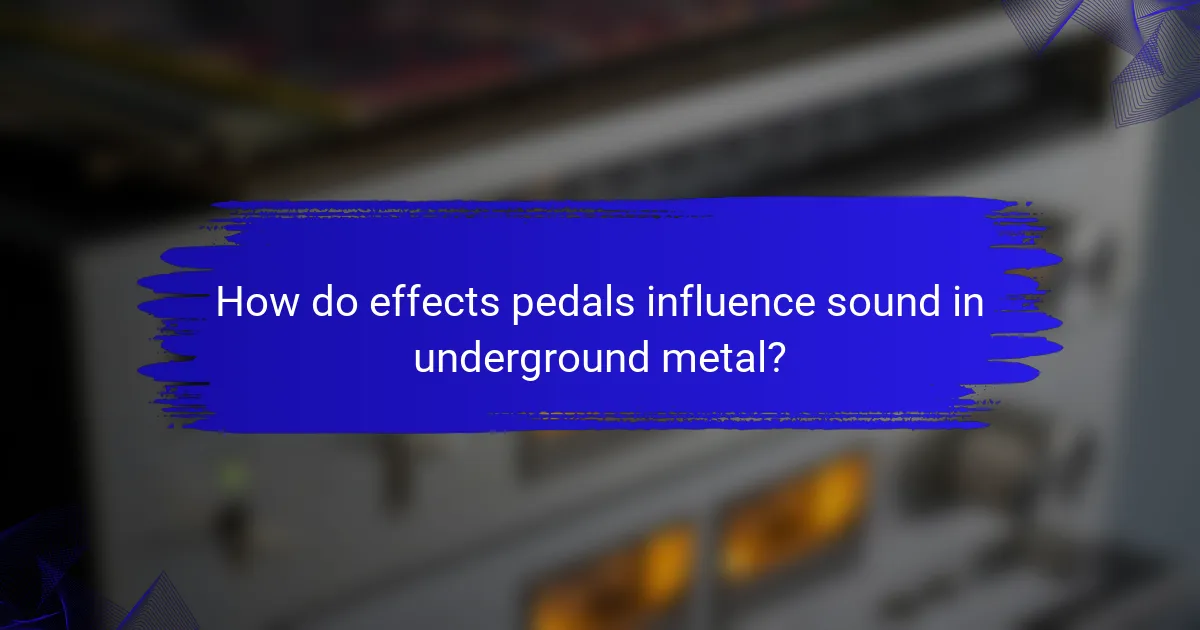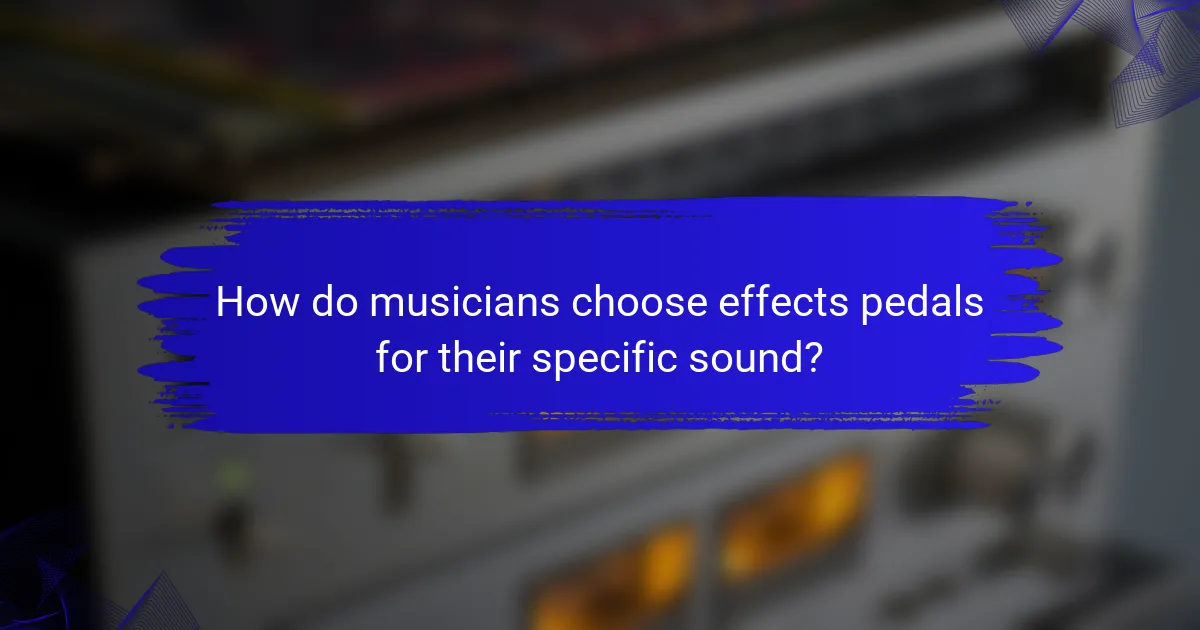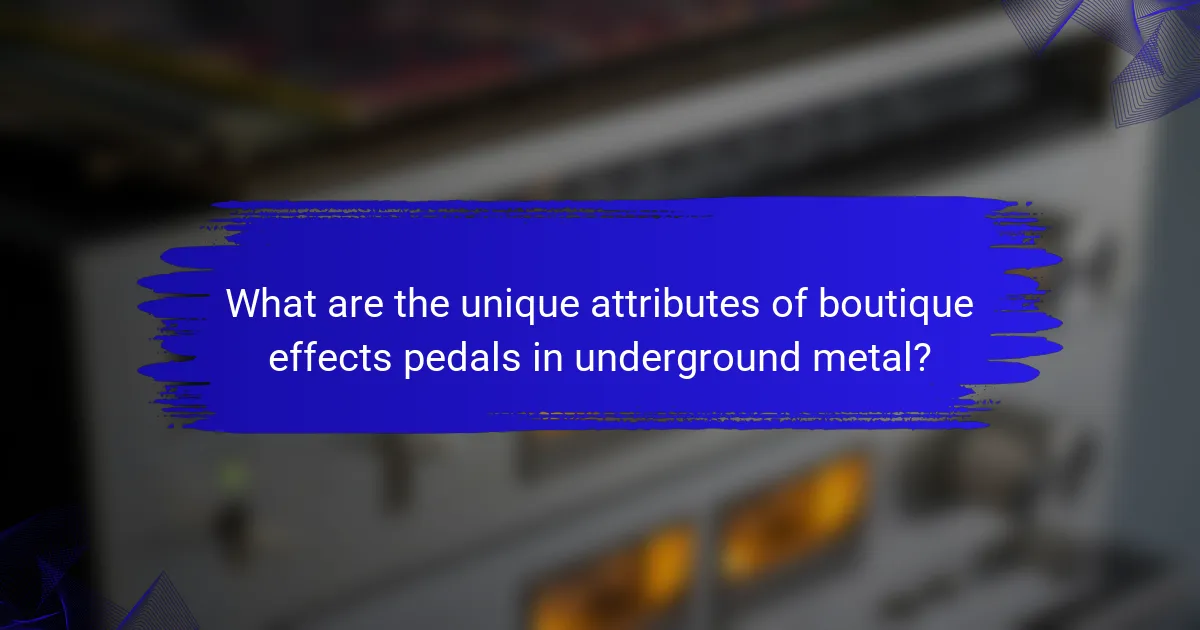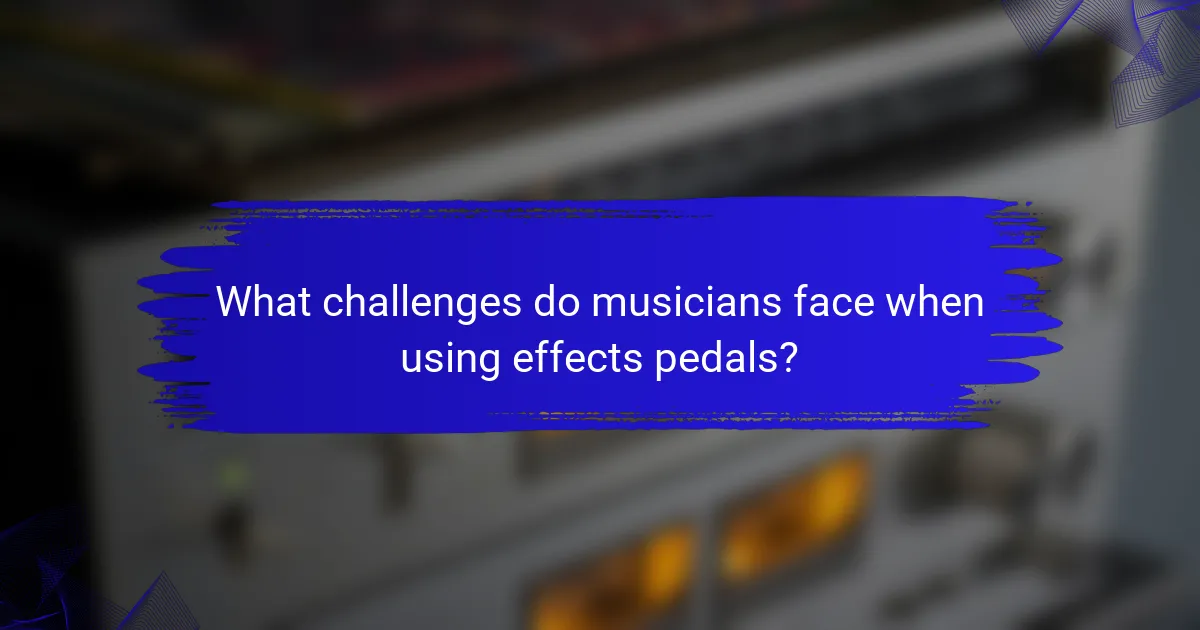Effects pedals are crucial for shaping the sound in underground metal, enhancing tone and texture. This article explores the types of pedals used, including distortion, reverb, and modulation effects. It also addresses challenges musicians face with setup complexity and signal interference. Finally, the importance of boutique pedals and their unique attributes will be highlighted.

How do effects pedals influence sound in underground metal?
Effects pedals significantly shape the sound in underground metal by adding texture and depth. Distortion pedals are essential, providing aggressive tones that define the genre. Reverb and delay create atmospheric layers, enhancing the overall soundscape. Modulation effects, like chorus and flanger, add movement and complexity. Each pedal type contributes unique attributes, allowing musicians to craft distinctive sonic identities. The right combination can result in a powerful and immersive listening experience.
What are the essential characteristics of effects pedals?
Essential characteristics of effects pedals include sound modulation, versatility, and ease of use. They alter the guitar signal to create unique tones, enhancing the overall sound in underground metal. Common types include distortion, delay, and reverb, each serving distinct purposes. Distortion pedals add grit, while delay pedals create echoes, and reverb pedals simulate space. The ability to stack multiple effects allows musicians to craft complex soundscapes, making effects pedals vital for achieving the desired metal sound.
Which effects are most commonly used in underground metal?
Effects pedals in underground metal commonly include distortion, overdrive, reverb, delay, and chorus. These effects shape the genre’s heavy sound and enhance musical expression.
Distortion pedals create aggressive tones, crucial for achieving the genre’s signature sound. Overdrive pedals add warmth and grit, allowing for dynamic range. Reverb and delay pedals contribute depth, enriching the overall atmosphere. Chorus pedals add modulation, creating a fuller sound.
Each effect serves a unique purpose, enabling musicians to explore a wide sonic palette. The combination of these effects is essential for defining the underground metal aesthetic.

What types of effects pedals are favored by underground metal musicians?
Underground metal musicians favor distortion, overdrive, reverb, delay, and modulation effects pedals for their unique soundscapes. Distortion pedals provide heavy gain, essential for achieving aggressive tones. Overdrive pedals add warmth and sustain, enhancing solos. Reverb creates atmospheric depth, while delay adds complexity. Modulation effects, like chorus and flanger, introduce movement and texture to the sound. These pedals are crucial for shaping the raw power and emotional intensity characteristic of underground metal music.
How do distortion and overdrive pedals shape the genre’s sound?
Distortion and overdrive pedals significantly shape underground metal’s sound by adding grit and sustain. These effects enhance aggressive guitar tones, allowing for a heavier and more dynamic musical expression. Distortion pedals create a more saturated sound, while overdrive pedals provide warmth and smoothness. This combination allows musicians to achieve a unique sonic identity, essential for the genre’s intensity. The use of these pedals can vary, with some artists favoring distortion for its raw power, while others prefer overdrive for its nuanced tonal qualities, showcasing the diverse soundscapes within underground metal.
What role do modulation effects play in creating atmosphere?
Modulation effects significantly enhance atmosphere in underground metal music by creating depth and texture. These effects manipulate sound characteristics, resulting in a more immersive listening experience. For instance, chorus and reverb can add layers, while distortion shapes the overall tone. The unique attributes of modulation effects allow musicians to craft distinct sonic identities, contributing to the genre’s diverse soundscapes. As a result, modulation effects are essential tools for achieving the desired emotional impact in compositions.
Why are delay and reverb pedals important for depth in metal music?
Delay and reverb pedals are crucial for adding depth in metal music. They enhance the atmosphere and create a spacious sound, allowing for intricate layering of guitar riffs and vocals. Delay pedals provide echoes that can build tension, while reverb adds a sense of space, making the music feel larger and more immersive. This combination is essential for achieving the complex soundscapes characteristic of underground metal.

How do musicians choose effects pedals for their specific sound?
Musicians choose effects pedals based on their desired sound, genre, and personal style. In underground metal, specific pedals enhance tone and texture, shaping the overall sonic landscape.
Key factors include distortion types, modulation effects, and delay characteristics. Distortion pedals provide grit and aggression, while modulation effects like chorus or flanger add depth. Delay pedals create atmospheric layers, essential for building tension in compositions.
Additionally, the integration of pedals into live setups influences choice. Musicians often prioritize versatility to adapt to various performance contexts. The unique attributes of each pedal, such as analog versus digital processing, further dictate selection.
Ultimately, experimentation and personal preference guide musicians in crafting their signature sound with effects pedals.
What factors influence the selection of pedals in different sub-genres?
The selection of pedals in underground metal is influenced by genre-specific sound characteristics, personal playing style, and desired effects. Key factors include distortion types, modulation effects, and dynamic response.
Distortion pedals are crucial for achieving heavy, aggressive tones, while modulation effects like chorus or flanger add depth. Additionally, the choice often reflects the unique attributes of the musician’s style, such as speed and complexity.
Pedalboard size and power supply compatibility also affect selection, as musicians prioritize portability and reliability during performances.
Ultimately, the interplay between these factors shapes the overall sound and expression in underground metal music.
How do personal preferences and playing style affect pedal choice?
Personal preferences and playing style significantly influence pedal choice in underground metal. Players often select pedals that align with their desired sound, whether it be heavy distortion or atmospheric effects.
For instance, a guitarist focusing on aggressive riffs may prefer high-gain distortion pedals, while a player emphasizing ambient textures might opt for reverb or delay pedals. Additionally, the interaction between pedals can vary based on playing style; for example, a fast-playing style may benefit from noise gates to maintain clarity.
Ultimately, the unique attributes of each pedal, such as gain levels and tonal shaping, cater to individual preferences and enhance the overall sound, making the right choice essential for achieving a specific musical vision.

What are the unique attributes of boutique effects pedals in underground metal?
Boutique effects pedals in underground metal are distinguished by their unique tonal characteristics, craftsmanship, and customization options. These pedals often feature rare components, handmade designs, and innovative circuitry that set them apart from mass-produced alternatives. Artists value their ability to create distinct sounds, enhancing the genre’s aggressive and experimental nature. Additionally, many boutique pedals offer limited editions or artist collaborations, further emphasizing their unique attributes.
How do handmade pedals differ from mass-produced options?
Handmade pedals offer unique tonal characteristics and customization options that mass-produced options lack. Handmade pedals are often crafted with high-quality components, resulting in superior sound quality and durability. In contrast, mass-produced pedals prioritize cost efficiency, leading to compromises in materials and design. Additionally, handmade pedals can be tailored to specific preferences, allowing musicians to achieve a distinct sound that suits their style. This level of personalization is rare in mass-produced alternatives, which typically offer a standard set of features.
Which boutique brands are gaining popularity among underground metal artists?
Boutique brands like EarthQuaker Devices, JHS Pedals, and Wampler are gaining traction among underground metal artists. These brands offer unique effects pedals that enhance sound quality and creativity.
EarthQuaker Devices is known for its innovative designs and versatile sound options, making it popular for creating heavy tones. JHS Pedals provides a range of customizable effects, appealing to artists who seek distinct sonic characteristics. Wampler is recognized for its high-quality craftsmanship, often used for achieving rich, dynamic tones in metal music.
The rise of these boutique brands reflects a shift towards personalized sound in underground metal, where artists prioritize unique tonal attributes over mass-produced equipment.

What challenges do musicians face when using effects pedals?
Musicians face several challenges when using effects pedals, including signal interference, complexity of setup, and the need for extensive practice. Signal interference can degrade sound quality, particularly in live settings. Complexity arises from managing multiple pedals, which can overwhelm performers. Additionally, mastering the nuances of each pedal requires significant time and effort, impacting overall performance.
How do pedal configurations impact live performances?
Pedal configurations significantly influence live performances by shaping the overall sound and dynamics. Different arrangements can enhance tone, create unique effects, and facilitate transitions between songs. For example, a series of distortion pedals can amplify aggression, while modulation effects can add depth. The choice of pedals and their order directly impacts how musicians express themselves on stage, allowing for personal style and creativity. Additionally, experimenting with configurations can lead to discovering rare soundscapes that resonate well with underground metal audiences.
What common issues arise with pedalboard setups?
Common issues with pedalboard setups include signal loss, power supply problems, and cable management challenges. Signal loss often occurs due to long cable runs or poor-quality connectors, affecting tone. Power supply issues arise when pedals require different voltages or currents, leading to noise or malfunction. Lastly, cable management can create clutter, making it difficult to troubleshoot or adjust pedals during performances.

How can effects pedals enhance live performance in underground metal?
Effects pedals significantly enhance live performance in underground metal by adding depth and creativity to sound. They enable musicians to manipulate tone, create unique effects, and express their artistic vision.
Common types of effects pedals used include distortion, delay, reverb, and modulation. Distortion pedals provide a heavier sound essential for metal, while delay and reverb add atmospheric layers. Modulation effects, such as chorus or flanger, create dynamic shifts, enriching the overall performance.
The use of effects pedals allows for greater sonic experimentation. Musicians can blend various effects to create signature sounds, setting their performance apart. This customization fosters a unique identity, crucial in the underground metal scene.
Moreover, effects pedals can enhance stage presence. Visual elements, such as pedal board setups, can engage the audience, creating a more immersive experience. The combination of sound and visual effects elevates the performance, making it memorable.
What techniques can musicians use to integrate pedals into their stage setup?
Musicians can integrate pedals into their stage setup by strategically placing them in the signal chain for optimal sound. Begin with a tuner pedal for accurate tuning, followed by distortion or overdrive pedals to shape tone. Next, incorporate modulation effects like chorus or flanger for depth. Delay and reverb pedals can be added at the end to create space and ambiance. Experimenting with pedal order can yield unique sounds, enhancing live performances.
How do effects pedals contribute to the overall audience experience?
Effects pedals significantly enhance the audience experience in underground metal by creating unique soundscapes. These devices manipulate tone and effects, adding depth and intensity to performances. For example, distortion pedals amplify aggression, while delay and reverb create atmospheric layers. This sonic diversity captivates listeners, making each performance memorable. Additionally, the visual aspect of pedal use engages the audience, as guitarists showcase their creativity and technical skills. Overall, effects pedals are essential in shaping the emotional impact of underground metal music.

What are the best practices for maintaining effects pedals?
To maintain effects pedals effectively, regularly clean connections, check for loose components, and ensure proper storage. Avoid exposing pedals to extreme temperatures and humidity. Use quality power supplies to prevent noise and protect circuits. Regularly test and calibrate settings for optimal performance.
How can musicians troubleshoot common pedal issues?
Musicians can troubleshoot common pedal issues by checking connections, power supply, and settings. Inspect cables for damage and ensure pedals are properly powered. Adjust settings to eliminate unwanted noise or feedback. If issues persist, test pedals individually to isolate the problem.
What tips can help extend the lifespan of effects pedals?
To extend the lifespan of effects pedals, store them in a stable environment and avoid excessive exposure to moisture. Regularly clean connections and controls to prevent corrosion. Use a power supply suited for the pedal’s specifications to avoid damage. Additionally, consider using a pedalboard to protect pedals during transport.